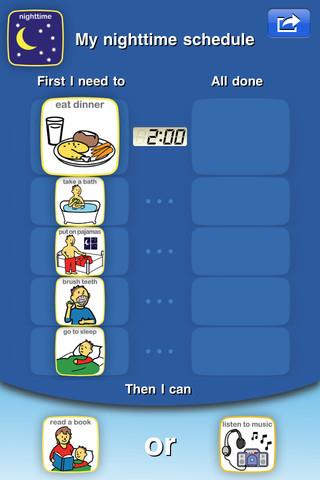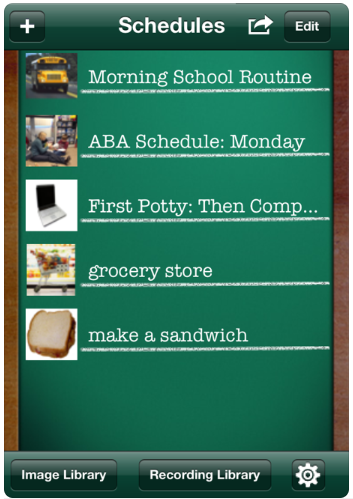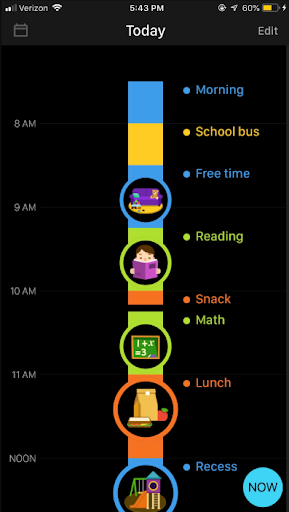-
Setting up Home Instruction for Students with ASD
A How-to Guide for ParentsPROVIDE STRUCTURE AND PREDICTABILITY
Children and youth with ASD tend to want things to be the same. They do well with activities that are scheduled and part of well-established routines. They are going to be more successful completing schoolwork at home with a space that is clearly designated for this purpose. Ideally, this space should be well-organized, free of clutter and with as few distractions as possible.
HOW TO DO IT
Designate a work area. Set up an area in your home where your child will be expected to complete learning activities. Remember that we want your child to feel good about using this space every day (we talk about motivation, reinforcement, and creating positive associations under Tip 3).
Like having a desk at school, the area you designate should be visually obvious to your child that it is an area specifically for schoolwork. Play and breaks should occur elsewhere. Take a look at the examples of well-defined areas at home for schoolwork.
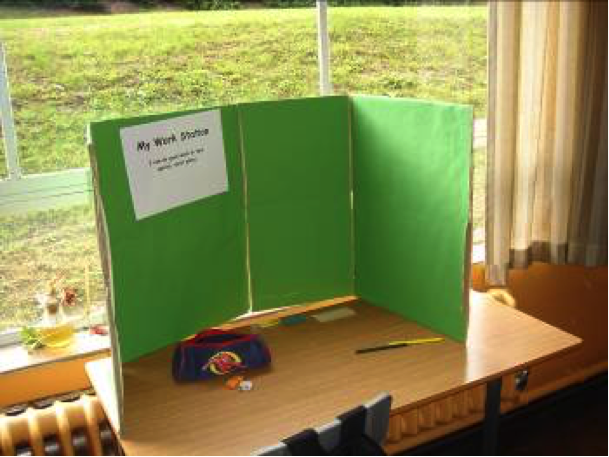
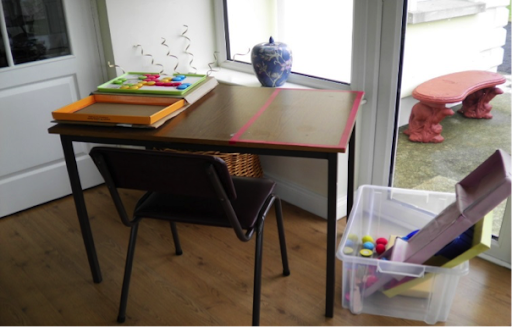
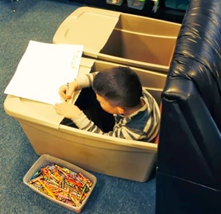
Pictured left to right (1) a trifold study carrell made of cardboard, (2) child desk with work to be done on the left and completed work placed in bin on the right, (3) masking/painters tape to mark off work section of a table (you can do this with a kitchen or dining room table), and (4) a storage container converted to a cozy little space to work.
Create a daily visual schedule that includes a time for schoolwork. Visual schedules are a very simple strategy that require no special tools to produce. For children with ASD, schedules reduce anxiety, promote on-task behaviors, and increase independence. Your child’s schedule should list activities in order such as “get dressed”, “breakfast”, “brush teeth”, “walk the dog”, “school work”, “TV break”, etc.
You can create a daily schedule for your child in whatever format you feel will be easiest for your child to understand. You can use written or printed words, line drawing, photos, or even small objects. For most children in preschool or elementary school, we prefer schedules that include both words and pictures in part because many children with ASD do better when information is presented visually.
Examples of visual schedules
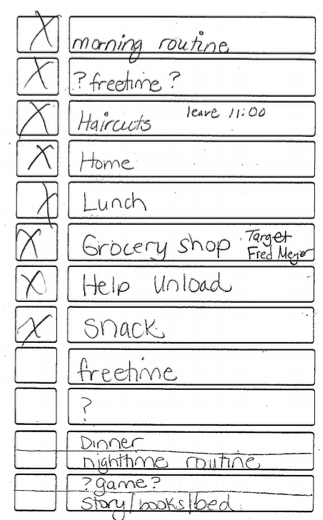
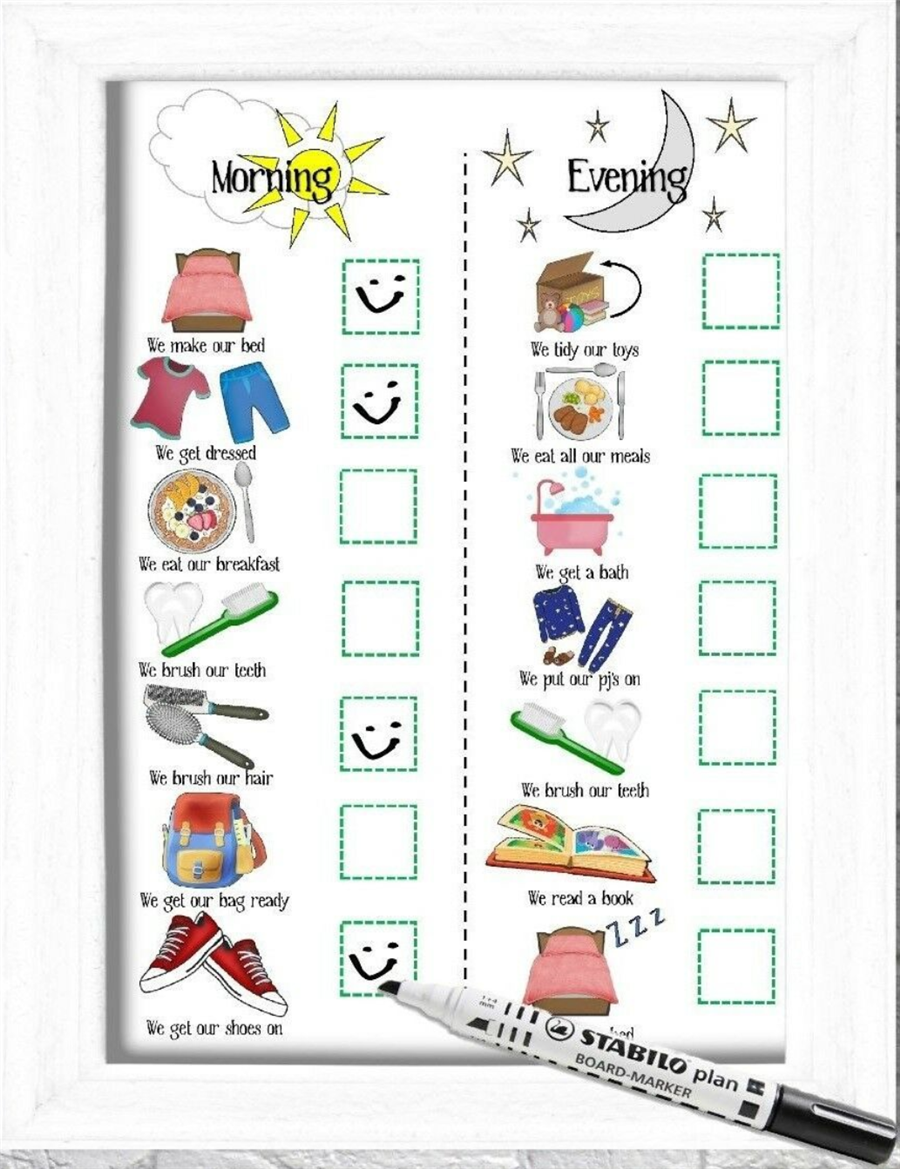
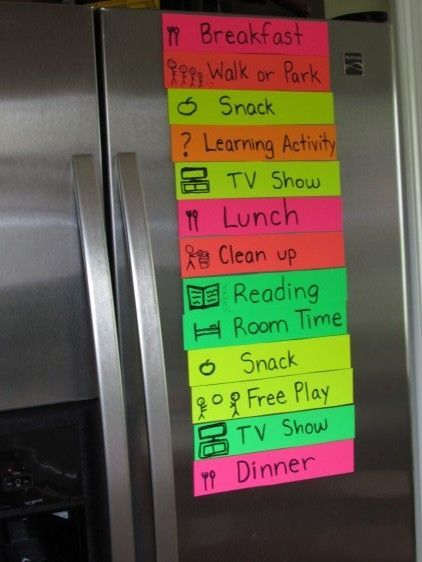
Pictured left to right (1) handwritten schedule with a space for a child to X off completed tasks, (2) printed 2"x2" Boardmaker symbols arranged vertically on a Velco strip that a child moves into the "all done" pocket as tasks are completed, (3) printed schedule placed in a picture frame so a child can re-use with a dry erase marker, and (4) strips of paper attached to magnets on refrigerator so a child can remove each activity when completed.
Schedule apps for iPhone and Android. There are also several visual schedule apps available for your iPhone, iPad, and Android devices including Choiceworks (below left), First Then Visual Schedule (below center), and Todo Visual Schedule (below right).
Teach your child to use a daily schedule. We have to teach children how to go through the schedule to know what is happening, how to mark off or remove what is done, and how to identify what is next. It is important for your child to interact with their schedule following each activity. For example, when breakfast is over you can say “Breakast is done. Check your schedule”. Depending on the type of schedule you created, your child can cross through the completed activity, put an “X” next to it, or move a picture symbol into the “Done” pocket.
Take a look at these two videos created by a parent on how to setup and use visual schedules.
Why is it better to say "check your schedule" instead of simply telling a child what to do next? As children learn to gain information from their environment to know what to do, they become more independent. If adults just tell them what to do at every transition, then we risk children becoming more dependent upon those verbal prompts. Create schedules and lists and then encourage your child to use them. We use schedules on our phones and to-do lists everyday!
How long should schoolwork times be? This varies greatly depending upon the age and developmental level of each child. Some children will have no problem doing schoolwork for 30-to-45 minutes straight followed by something they like (e.g., a fun activity, points toward a bigger reward). To be successful, other children will need to alternate between 5 minutes of work followed by 5-minutes of a preferred activity. That's ok! Whenever possible, we want to avoid pushing children to a point of frustration. It is better to "end on a high note". If your child is working and doing well, it might be tempting to keep pushing them. However it is better to give your child a break while they are working and doing well, before difficult behaviors are triggered. You are not alone. Many parents grapple with finding the right balance between pushing their child to achieve and knowing when to back off. Under Tip 3, we discuss ways to motivate your child to complete tasks and ensuring that they feel good when completing schoolwork at home.
Create a mini-schedule for your child's schoolwork time. To further help your child, certain activities or routines can be broken down into steps. Think of it as a schedule within a schedule, that's why we call these mini-schedules. Here are some examples.
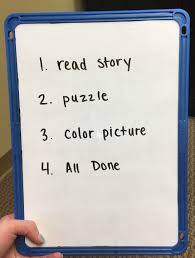
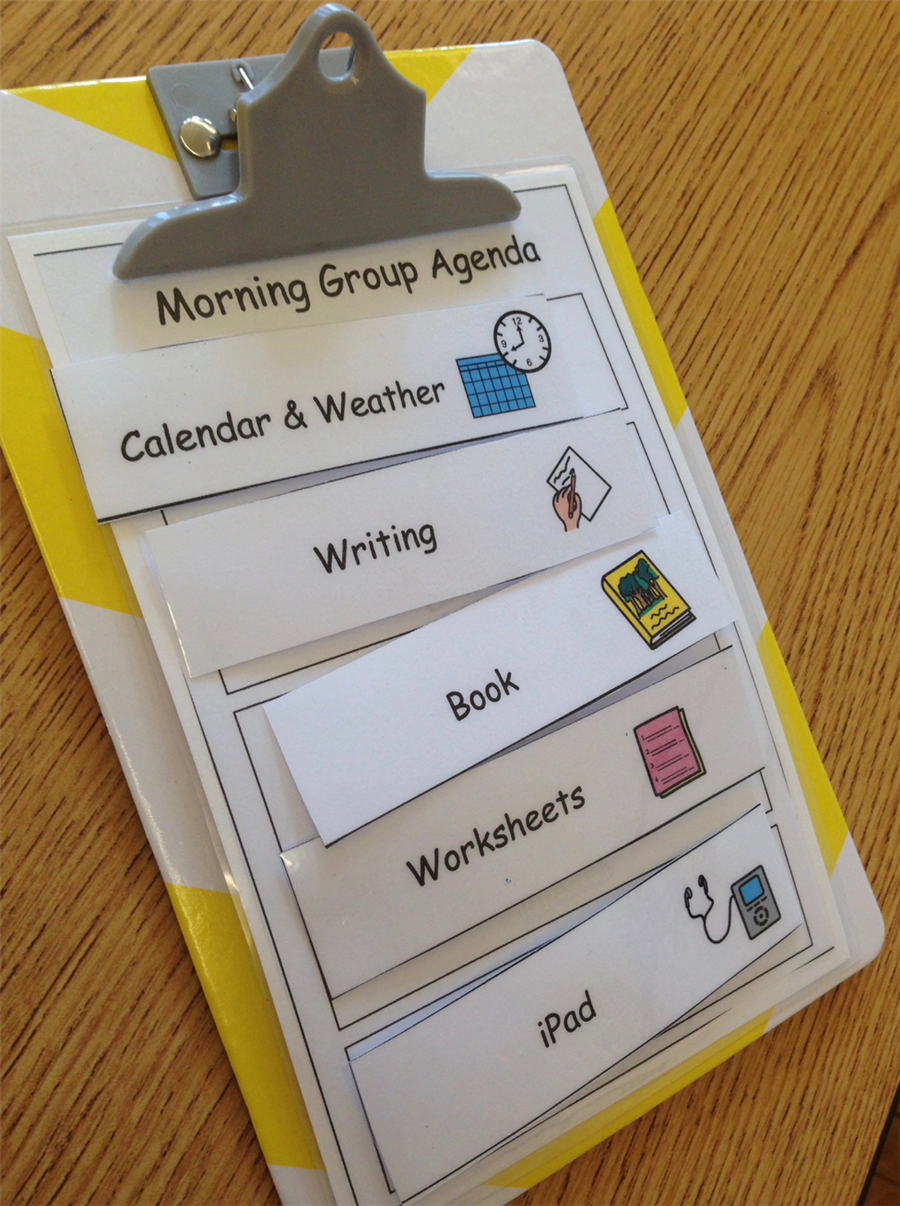
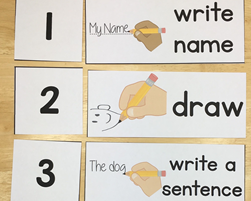
Remember, as your child completes each step in the routine we want them to mark off, x through, or remove what is done on the mini-schedule and then identify what is next. Instead of telling them the next step, prompt them to look at their mini-schedule.
Make schoolwork activities visually clear for your child. When it comes to the specific learning activities that you want your child to complete, be aware that learners with ASD do better when tasks are as visually clear as possible. With every task we present, we want it to be visually obvious:
(1) What they are supposed to do (what the task or activity is);
(2) How much they are supposed to do;
(3) How they will know that they are done with a task; and
(4) What they need to do next.
Examples of ensuring schoolwork is visually clear
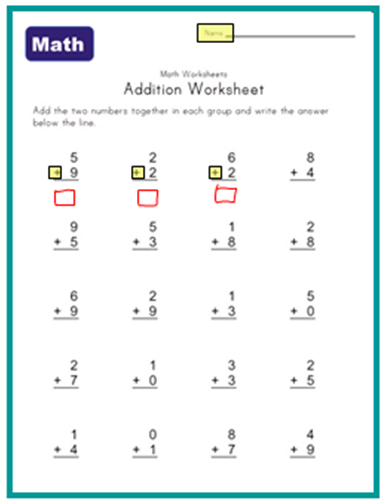
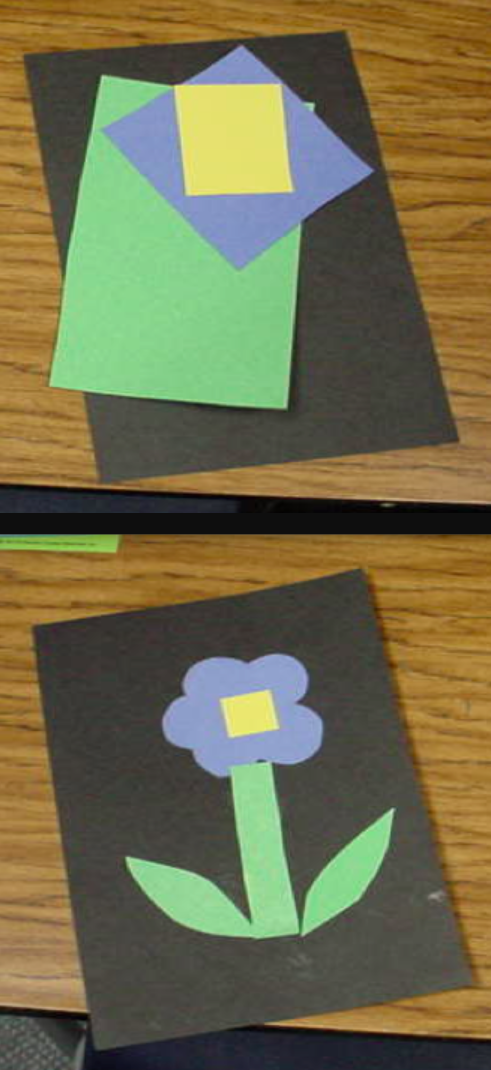
Pictured left to right (1) a math worksheet that provides clarity regarding the type of math problem (addition) and where to write the answer, (2) a math worksheet that shows a green dot for where to start and a red dot with where to stop and the other problems are crossed off so it is visually clear to the child they only have to do the first eight problems, and (3) providing an example of the final product is a great way to provide visual clarity with, in this case, cutting pieces of paper to create a flower image (child has a visual model to match).
In review...
➤ Designate a schoolwork area in your home
➤ Create a daily schedule that includes a set time for schoolwork
➤ Teach your child to use and interact with their schedule at every transition
➤ Create a mini-schedule for their schoolwork time
➤ Ensure schoolwork is visually obvious what to do, how much, when to stop, and what is next
ADDITIONAL RESOURCES TO PROVIDE STRUCTURE AND PREDICTABILITY
Let's Make a Schedule (video tutorial on creating a schedule for your child using an online tool)
How to Teach Students to Use a Visual Schedule
Many examples of making tasks visually clear
Next page Tip 2: SUPPORT SUCCESSFUL TRANSITIONS BETWEEN ACTIVITIES
 Setting up Home Instruction for Students with ASD
Setting up Home Instruction for Students with ASD
A How-to Guide for ParentsDeveloped by autism specialists at Columbia Regional Program
Email questions or feedback to crpweb@pps.net





